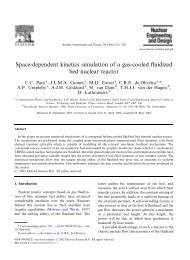Chapter 8 Configuring Fluidity - The Applied Modelling and ...
Chapter 8 Configuring Fluidity - The Applied Modelling and ...
Chapter 8 Configuring Fluidity - The Applied Modelling and ...
You also want an ePaper? Increase the reach of your titles
YUMPU automatically turns print PDFs into web optimized ePapers that Google loves.
28 Numerical discretisation<br />
where we have substituted c = �<br />
j ϕjcj. From this it is readily seen that we have in fact obtained a<br />
matrix equation of the following form<br />
where M, A <strong>and</strong> K are the following matrices<br />
�<br />
Mij =<br />
3.2.1.3 Advective stabilisation for CG<br />
Ω<br />
M dc<br />
+ A(u)c + Kc = 0, (3.8)<br />
dt<br />
�<br />
�<br />
ϕiϕj, Aij = − ∇ϕi · uϕj, Kij = ∇ϕi · µ · ∇ϕj. (3.9)<br />
Ω<br />
Ω<br />
It is well known that a continuous Galerkin discretisation of an advection-diffusion equation for an<br />
advection dominated flow can suffer from over- <strong>and</strong> under-shoot errors. Furthermore, these overshoot<br />
errors are not localised: they can propagate throughout the simulation domain <strong>and</strong> pollute the<br />
global solution [Hughes, 1987]. Consider a simple 1D linear steady-state advection-diffusion problem<br />
for a single scalar c:<br />
or equivalently in weak form:<br />
�<br />
Ω<br />
u ∂c<br />
∂x − κ ∂2c = f(x), (3.10)<br />
∂x2 ϕ(u ∂c<br />
∂x<br />
∂c<br />
+ κ∂ϕ − f(x)) = 0, (3.11)<br />
∂x ∂x<br />
where we have integrated by parts <strong>and</strong> applied the natural Neumann boundary condition ∂c/∂x =<br />
0 on ∂Ω. Discretising (3.11) with a continuous Galerkin method leads to truncation errors in the<br />
advection term equivalent to a negative diffusivity term of magnitude [Donea <strong>and</strong> Huerta, 2003]:<br />
where:<br />
<strong>and</strong>:<br />
ξ =<br />
is a grid Péclet number, with grid spacing h.<br />
¯κ = ξκPe, (3.12)<br />
1 1<br />
− , (3.13)<br />
tanh(Pe) Pe<br />
Pe = uh<br />
, (3.14)<br />
2κ<br />
This implicit negative diffusivity becomes equal to the explicit diffusivity at a Péclet greater than one,<br />
<strong>and</strong> hence instability occurs for Pe � 1. In order to achieve a stable discretisation using a continuous<br />
Galerkin method one is therefore required either to increase the model resolution so as to reduce the<br />
grid Péclet number, or to apply advective stabilisation methods.<br />
Balancing diffusion A simple way to stabilise the system is to add an extra diffusivity of equal<br />
magnitude to that introduced by the discretisation of the advection term, but of opposite sign. This<br />
method is referred to as balancing diffusion. Note, however, that for two or more dimensions, we<br />
require this balancing diffusion to apply in the along-stream direction only [Brooks <strong>and</strong> Hughes,<br />
1982, Donea <strong>and</strong> Huerta, 2003]. For this reason this method is also referred to as streamline-upwind<br />
stabilisation. <strong>The</strong> multidimensional weak-form equation:<br />
�<br />
ϕ(u · ∇c + κ∇ϕ∇c − f(x)) = 0, (3.15)<br />
Ω




